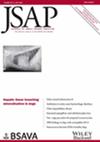Efficacy and tolerability of the American Heartworm Society therapeutic protocol in dogs affected by heartworm disease without caval syndrome
Abstract
Objectives
The American Heartworm Society medical protocol represents the current standard of therapy for canine heartworm disease without caval syndrome. However, data on the tolerability of this protocol are limited. This study aimed to describe efficacy and prevalence of possible treatment-related side effects in dogs with heartworm disease treated using the American Heartworm Society protocol.
Materials and Methods
For this retrospective multi-centre cohort study, dogs diagnosed with classes 1 to 3 heartworm disease that completed the American Heartworm Society medical protocol were searched in four medical databases. Demographic, clinical, diagnostic, therapeutic and outcome data, including the number and type of possible treatment-related side effects, were retrieved.
Results
Thirty-five dogs were included. The median age and bodyweight were 6 years (1 to 13 years) and 17.3 kg (4.9 to 50 kg), respectively. Heartworm disease was classified as classes 1, 2 and 3 in 20 of 35, 11 of 35 and four of 35 dogs, respectively. In addition to the therapeutic recommendations of the American Heartworm Society, eight of 35 dogs underwent sedation to favour melarsomine administration, and 30 of 35 received ice at the injection site. After adulticide therapy, all dogs were hospitalised with cage rest [median time 12 hours (6 to 48 hours)]. All dogs survived the treatment. All dogs with long-term follow-up (32/35) became negative. Furthermore, treatment-related side effects were rare, mild and rapidly recovered without the need for supporting therapies; these included depression/lethargy (4/35 dogs), cough (2/35 dogs) and lameness, pain and gastrointestinal signs (1/35 dog each).
Clinical Significance
The American Heartworm Society medical protocol is efficient and safe in dogs with classes 1 to 3 heartworm disease.

| 公司名称 | 产品信息 | 采购帮参考价格 |
|---|
 求助内容:
求助内容: 应助结果提醒方式:
应助结果提醒方式:


